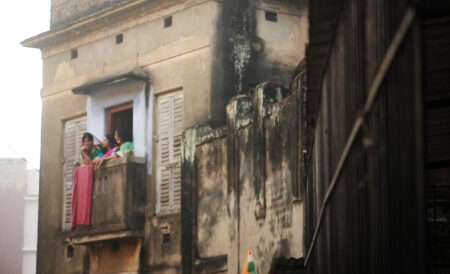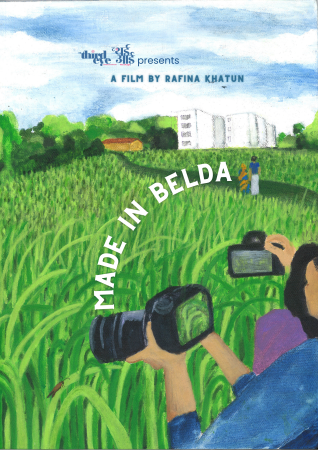Hameeda has participated in the EduLog programme with The Third Eye for its Education Edition. EduLog mentored 12 writers and image-makers from India, Nepal and Bangladesh to remember – in the present continuous – their experience of education through a feminist lens.
In 2006, on a fateful Friday in Riyadh, Saudi Arabia, my father’s younger cousin came to visit us after attending the recommended congregational (Jummah) prayers. We relished my mother’s korma on the dastarkhwan, topping it off with a cup of kahwa. After everything was put away, my father seated himself beside his cousin on the floor to dismantle the rice cooker. I sat a few metres away on the couch, absent-mindedly gazing at him working. There was a long silence before his cousin began quoting the verse:
“I was wonderstruck when I saw the ocean on fire
I have seen another miracle: the fish left the ocean and climbed up a tree.”
The ulatbaansi (upside-down verse) was attributed to Kabir, the acclaimed Indian poet who shunned all divisions within different religions and celebrated the divine oneness of God. Intrigued, I asked him what it meant. He laughed and shrugged, “The more you get into spirituality, the crazier you’ll become.” My father threw him a sharp, wordless glance before going back to his current project of putting away the rice cooker.
“My cousin doesn’t know what he’s talking about,” my father said to me after he had left. “He does not have much exposure or reflection. There’s no such thing as being crazy in spirituality.”
In popular rhetoric, spirituality and religion were assumed to be two separate offshoots of each other. They were well known in academic parlance as ‘esoteric’ and ‘exoteric’, and in pure Arabic, the baatin (the hidden), and the zaahir (the apparent). God embodied both names, being the Omnipresent and Omniscient Creator. Yet for the majority of believers, the apparent side of the coin—religion—made much more sense, especially over expectations on and of women.
One of these much-debated expectations was the headscarf, popularly known as the hijab.
On my birthday this year, I went on a short trip to Thailand on an advocacy mission. My friends, also my co-workers, and I decided to extend our stay to explore the country. During one of our stops in Pattaya, an island city three hours from Bangkok, we visited the beach and acquainted ourselves with the nearby area.
One lazy day, we decided to walk the length of it. I let my companions go ahead and sat down on a concrete slope turning toward the waves. The slope was low, making it easier for the water to splash against my feet. Enjoying the moment, I rested my chin on my arms and gazed into the vast waves and the unfathomable depth of the sea.
There was a light breeze but with all the layers of the hijab, I couldn’t feel it. Seeing that no one was immediately around me, I removed my scarf from its pinned foundation and, for a brief moment, let my hair feel the wind after 17 years.
The last time I felt the wind in my hair was in 2004. I was eight years old and inside a small apartment in the capital city of Riyadh, Saudi Arabia. I was gazing through the window, a favourite pastime. I could tell there was a strong breeze blowing outside by the way the men were holding on to their kufiyas (headdresses) and their vigorously flapping robes.
My father and mother, born and bred in Kashmir, had come to the country and moved across different cities, finally settling here. My father worked as a physiotherapist and my mother, a stay-at-home wife. She had left her job as an Urdu teacher shortly after getting married.
My mother had dropped a glass vase that day. Before her husband went on hospital duty, she had negotiated to take it out of the cupboard. She was usually exasperated with his tendency to live within necessary means. After the vase broke, she gestured to me to remove the evidence with strict instructions.
Excited, I nodded and put on my chappals, grabbing the bag from her. I took my time going downstairs. It had been a week since I had stepped out of the house. At least that’s how it was back then if you didn’t have a male to accompany you.
Upon leaving the building, the wind hit my hair and neck. I remembered an Indian advertisement I had seen a few months ago when we briefly visited relatives in Srinagar. A woman wearing a pink dress was swaying her head back and forth, showing off her beautiful hair to the viewers.
I could feel the happiness the woman felt. I hummed the jingle and mimicked her movements while I dumped the plastic bag into the big, yellow container. Out of the corner of my eye, I could see a line of Filipino men sitting outside a shop, smoking, and staring intently at me. But I ignored the prickly feeling and came back, cherishing the short fleeting moment.
When I came upstairs and opened the door, my mother’s wide eyes looked at me with sharpness. “I saw what you did,” she said, “I’m going to speak to your father. It’s time you wore the scarf.”
When my father came home that day, my mother took him to the kitchen and spoke to him in a low tone. I, meanwhile, remember looking out the window, feeling helplessness, full of guilt and tears of regret.
Soon, I began wearing the scarf when I went out.
I was the only girl sporting it out of 30 others in my school. It was stuffy and heavy. Many times, when rushing off to school, I would forget to wear it altogether. I imagine it happened because I didn’t feel the need to hide my hair which I felt was such a natural part of my body. But my father’s instructions were clear.
“You must embody it as if you are a follower of Hazrat Zainab,” he said. Hazrat Zainab was a well-known figure among Shia circles. The sister of Imam Hussein, the grandson of the Last Prophet, she embodied poise, honour, bravery and sacrifice. Every woman and girl in the Shia community was exhorted to look up to her, especially when commemorating Imam Hussein’s martyrdom. Spurning allegiance to the tyrant Yazid, he and his 72 followers had stood against an army of 10,000 in a land called Karbala.
Hazrat Zainab was an integral part of the battle. As the pulpit leader would orate, when she was dragged to Yazid’s palace as a prisoner of war, her hair was exposed for the first time since birth in front of leering men; she stood high and condemned with disgust Yazid’s power tactics. Following public uproar over Yazid’s disrespect, she was finally released, along with other women and her ailing brother. Upon reaching home, the people of her town flooded her house asking her to narrate what she saw. She said, “I saw nothing but the beauty of God.”
Through these orations that happened in closed quarters, with the fear that the Saudi regime would sniff us out, I realised being a Muslim woman meant going against the established current. In school, when I learned the Earth rotated every day, my father asked, “Who makes it rotate?” I was encouraged and emboldened to look at my religion as my only source of knowledge, and school as a system that offered occasional moments for learning common worldly facts.
Soon, my attitude towards my scarf changed, and I began to wear it with more consideration and dignity than usual. If I spoke too loudly or laughed too much, I would sit in shame for a few minutes and berate my personality.
But two years later, when I heard my father’s cousin narrate Kabir, something else awakened.
The mystic’s ancient wisdom of fusing two contradictory moments of existence made me intensely curious, and even more, afraid.
And in Thailand, after 17 years, I would finally understand my fascination with this verse as I looked at the ocean and felt my hair dancing in the breeze. Over there, I felt a vast silence within me, even more expansive than the sea itself. I found solace in briefly showing my most naked self. I looked at the sky, out of habit, and imagined Allah’s soft presence looking at me with Love, permitting me to be in this state of equilibrium. Allah was tipping the scales between the apparent and the hidden to concoct a sweet melody of the hijab—one that moved beyond the realm of the traditional. I could hear myself asking to be moved, to be swept away with the waves of Love, so certain, so absolute, that everything within me melted to become a river taking me to Heaven.
Over time, I realised, not every Muslim woman felt or experienced the same relationship with themselves.
My sister, for instance, just like many believing women felt they were forced to choose a side. Since childhood, she was more religious than I was and practised the rituals with careful obedience. As a result, she enjoyed a fruitful relationship with our father and was regularly praised for her sensibility and forethought. She was the perfect, straight-A student and daughter, and was known among many circles in school as a responsible, mature girl.
My sister also played a huge influence in teaching me about Islam. One day during school, a woman teacher took a substitute class to teach us about the concept of being gay. “Being gay means you can love anyone,” I remember her saying. Excited to have a word that could finally describe my feelings for my sister, I went to her after school and proclaimed happily,
“I’m gay for you!”
My sister’s face turned into one of shock and horror and she lightly pinched my shoulder. “That’s not allowed with Allah, you can’t think like that,” she said, leaning forward and looking at me worriedly. “You can’t look at me like that, you understand?”
Ashamed of having made her and Allah unexpectedly upset with me, I buried the feeling deep under my heart with a thought, “What word should I use to say I love her?”
But after my mother, my sister and I returned to Kashmir in 2009, I saw my sister’s carefully crafted structure of traditional goodness disintegrate over time. When she went to college in Delhi to pursue a literature degree, she came back with books authored by Virginia Woolf and Simone De Beauvoir. She made me sit next to her and gave them to me with a tender touch.
“Virginia will make you tear yourself apart and rebuild yourself from the scratch,” she said. “Listen to her.”
“Simone will make you strong and aware of your rights,” she said. “You will begin to realise how less of a friend to yourself you are.”
I could see how the books had encouraged her to critically look at her roots and the religious education received in the small confines of our life in Saudi. Among many things, she felt the force of the headscarf upon her head. Women in Muslim communities would exhort each other, and allow themselves and be exhorted by men, to cover their heads based on this verse:
“Say to the believing women that: they should cast down their glances and guard their private parts and not display their beauty except that which is apparent, and they should place a piece of cloth over their bosoms.” (Chapter 24: Verse 31).
When put in the context of De Beauvoir’s words: “It is perfectly natural for the future woman to feel indignant at the limitations posed upon her by her sex. The real question is not why she should reject them: the problem is rather to understand why she accepts them,” there was quite a lot of chaos ensuing in my sister’s head.
These very same books that meant so much to her were perceived as enemies to the upbringing our parents had given her. Our father abhorred the quotes and constantly pointed out how none of it could be applied to South Asian Shia culture.
Yet, my sister persisted.
One day, my sister was told that our father’s blood brother and his family would be visiting. The family had close ties to the political and religious Shia leaders in Kashmir, making it all the more pertinent for us to be on our best behaviour. My sister, at that time, had loosened the scarf upon her head, showing sizable portions of her hair, and would often appear in front of guests without the scarf itself.
That day, our mother took her aside and asked her to wear the scarf. My sister refused. Wordlessly, my mother went about her chores and greeted our relatives as they came. Incidentally, their young sons had also decided to come that day. By religious law, they were not permitted to see a distant relative’s hair. As they all sat down and spoke animatedly, my sister came inside the room to greet them. There was a sudden hush, and our two male cousins cast eyes downwards out of shock. My sister looked nonchalant as she sat down next to our mother, but I could see her hands shaking. She looked directly at our two cousins and spoke. They responded tersely to her questions.
After a long pause, their mother looked at ours and said, “What has happened? Do you not have anything to say to your daughter right now? Where is her veil?”
Our mother looked at her and quoted a verse from the Holy Book, one that is famously attributed to the Prophet when asked about inviting someone to the religion:
“There is no compulsion in religion.” (Chapter 2: Verse 256)
My sister and I looked at her in surprise: my sister out of warmth and blooming love, and I out of the intense epiphany that her words had caused inside of me. In that moment, and in the years to come, I realised what I had witnessed. My mother had demonstrated a perfect blend of accepting the apparent and collective responsibility of the headscarf while providing room for the hidden, individual spirituality of the self. Even more, my mother honoured my sister’s decision in an act of feminist solidarity. At that moment, I could draw parallels between her and Hazrat Zainab, who looked at how the world interpreted her sorry, sorry fate of pain and challenged it by creating her own interpretation—one dipped in beauty.
It also made me contemplate how her words worked like Kabir’s verses, by dissolving the tension in the room. While for me, a different question emerged. Did I need to remove the headscarf to understand ‘freedom’? Did I need to keep it to understand ‘purity’? Could I, instead, dare to bear a collective responsibility to wear the hijab, without having a personal identity attached to it?
More importantly, did that make me Muslim enough?
Since birth, as women, we see inferiority dominate our lives. Be it private or public spaces, this unwilling relationship with power and privilege shapes us. For me, I saw that power in the way knowledge was exchanged, crafted, interpreted and disseminated across communities.
For instance, in a Shia congregation on Muharram in Kashmir, the orator would be the one responsible for delivering lectures on a relevant societal issue and binding it to the events and the ethical stance of the Karbala. If it happened to be a man, as it usually was in big gatherings, he would be considered a ‘moulana’, a term denoting excellence of one’s position in matters of spirituality and having knowledge of its intersection with individual and social responsibility.
If the orator were a woman, she would be called a ‘zakira’, the feminine counterpart of the Urdu/ Arabic word, zikr, meaning remembrance. It would mean her penchant for “remembering” the events of Karbala and narrating them. Interestingly enough, a separate group of zakirs in men’s gatherings would be seated below the moulana and would primarily speak to evoke lamentation and condolences.
This distinction itself created an intellectual separation.
This separation was also seen in other knowledge institutions. If I was able to clear any doubts regarding a class topic with my friend, I was automatically labelled as a teacher and a possible good mother. If any of the boys in my class would do the same, they were called ‘intelligent’, and had a ‘bright future’. In whichever ways knowledge was taught to me, they had their own restraints and spaces of freedom.
This led to a thought: was it possible, then, for me to find the two ends of opposing ropes— one of religion and one of freedom—and bind them together to create an eternal bond of serenity? Could women, like Kabir, inhabit God through the zaahir and baatin, an ancient practice that was lost in the seismic battles of science and religion, feminism and orthodoxy, and between secular and religious knowledge? Was there truly any difference between the two?
My parents used to tell me my grandmother was sad for two days that I was born a girl. Sometimes, after hearing my father yearn for more male support in the house, even I was. But today, having been witness to my father’s tightrope walk around faith, my sister’s radical re-imagination of her life, and my mother’s rock-like stance, I am humbled by the freedom I see people find for themselves. Though our interpretations of religious knowledge may vary, from Iran to India, our essence is the same. Each and every one in a hijab is taking slow marches to understand and find beauty for themselves, the way Hazrat Zainab saw, between desire and duty.
You can join me if you’d like. There is no compulsion here.





